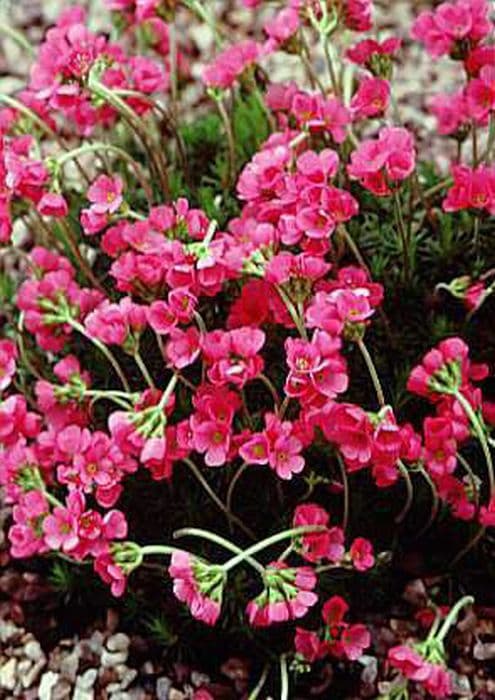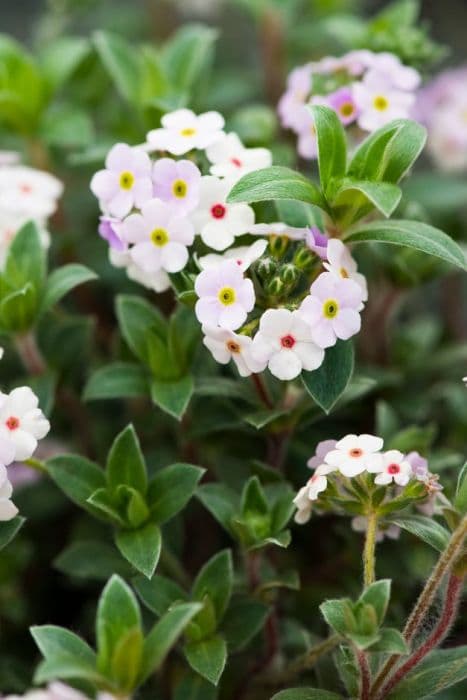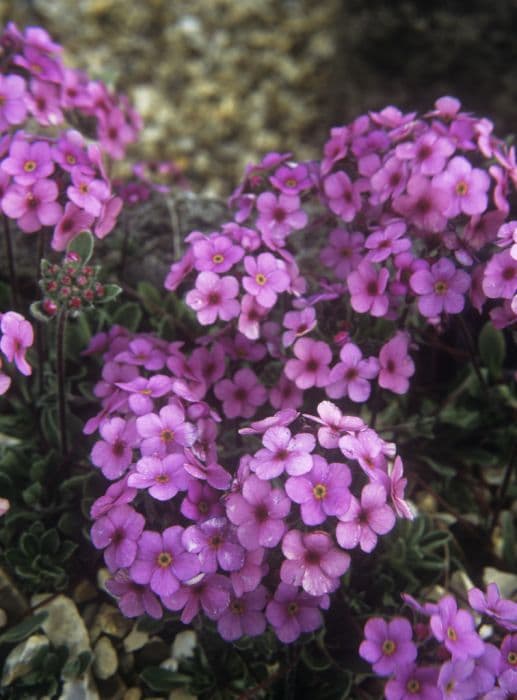Persian Violet Cyclamen 'Miracle White'

ABOUT
Cyclamen 'Miracle White' is a striking ornamental plant known for its beautiful, upswept flowers that resemble shooting stars or fluttering butterflies. The blooms are pristine white in color, offering a clean and bright contrast against the plant's backdrop. Each flower has a unique shape with reflexed petals that sweep upwards and outwards, creating an elegant and graceful appearance. The foliage of Cyclamen 'Miracle White' is equally attractive, with heart-shaped leaves that often display intricate patterns. The leaves can show a range of green tones, and sometimes they feature silvery marbling or variegation, adding to the visual interest of the plant. Typically, the base of the plant, where the stems meet the soil, forms a rounded tuberous structure which is the energy-storing organ for the plant. This structures's textured surface might sometimes be visible with the delicate stems arising from its top. Overall, Cyclamen 'Miracle White' is esteemed for its stunning white blooms that provide a touch of elegance and its decorative foliage that keeps the plant interesting even when it's not in flower.
About this plant
 Names
NamesFamily
Primulaceae
Synonyms
Persian Violet, Sowbread
Common names
Cyclamen persicum 'Miracle White'.
 Toxicity
ToxicityTo humans
Cyclamen is considered toxic to humans if any part of the plant is ingested. The most toxic part is the tuber, which can cause symptoms such as nausea, vomiting, and diarrhea if consumed. Other possible effects of cyclamen poisoning include abdominal pain and a feeling of general malaise. Ingestion of cyclamen should be avoided, and medical attention should be sought if ingestion is suspected.
To pets
Cyclamen is also toxic to pets, with the tuber being the most poisonous part. If a pet ingests any part of a cyclamen plant, they may experience symptoms such as vomiting, diarrhea, salivation, and a decrease in appetite. In severe cases, ingestion can lead to heart rhythm abnormalities, seizures, or even death. Pet owners should keep cyclamen plants out of reach of their animals and seek veterinary help if they suspect their pet has ingested any part of the plant.
 Characteristics
CharacteristicsLife cycle
Perennials
Foliage type
Evergreen
Color of leaves
Varies
Flower color
White
Height
6 inches (15 cm)
Spread
6 inches (15 cm)
Plant type
Bulb
Hardiness zones
9
Native area
Mediterranean
Benefits
 General Benefits
General Benefits- Ornamental Appeal: Cyclamen 'Miracle White' has beautiful pure white flowers that add aesthetic value to gardens and indoor spaces.
- Compact Size: It is ideal for small spaces or as a tabletop plant due to its compact growth habit.
- Long Blooming: This cultivar often features a prolonged blooming period, providing color and interest for several months.
- Seasonal Interest: Blooms typically in autumn, winter, or early spring, when most other plants are dormant, offering seasonal color.
- Low Maintenance: Requires relatively little care beyond proper watering and occasional feeding, making it suitable for busy gardeners.
- Drought Tolerant: Once established, it is fairly tolerant of dry conditions, reducing the need for frequent watering.
- Attractive Foliage: The heart-shaped leaves add to its visual appeal even when the plant is not in bloom.
 Medical Properties
Medical PropertiesThis plant is not used for medical purposes.
 Air-purifying Qualities
Air-purifying QualitiesThis plant is not specifically known for air purifying qualities.
 Other Uses
Other Uses- Cyclamen can be used in the art of flower pressing for creating natural artwork or preserving memories of a garden.
- The tubers of cyclamen when sliced can serve as a natural canvas for children to practice stamping with non-toxic paint.
- Dried and preserved cyclamen flowers can be used to create delicate bookmarks, enhancing the joy of reading with a touch of nature.
- Live cyclamen plants can be used in photography to add a touch of elegance to shots, serving as beautiful props, especially in keen macro photography.
- Cyclamen petals can be used in potpourri mixes to add a bit of color, although typically they do not retain much fragrance when dried.
- Small cyclamen plants can be creatively used in fairy gardens, providing a whimsical and colorful element that mimics larger flora.
- Cyclamen can be incorporated into seasonal wreaths for decorative purposes, especially during winter when it's flowering.
- Whole cyclamen flowers can be frozen in ice cubes to create visually captivating additions to drinks for special occasions.
- Their vibrant blossoms can be used as natural confetti for outdoor celebrations, as they are biodegradable and eco-friendly.
- With their attractive foliage, cyclamen plants can be used in terrariums, adding both color and texture to the mini-ecosystems.
Interesting Facts
 Feng Shui
Feng ShuiThe Cyclamen is not used in Feng Shui practice.
 Zodiac Sign Compitability
Zodiac Sign CompitabilityThe Cyclamen is not used in astrology practice.
 Plant Symbolism
Plant Symbolism- Love: Cyclamen is often associated with deep love due to its heart-shaped leaves and its long-lasting flowers that symbolize enduring affection.
- Sincerity: The pure white color of the 'Miracle White' variant exemplifies honesty and purity of feelings.
- Goodbye: In some cultures, Cyclamen is given as a parting gift to express the sentiment of 'goodbye' or 'until we meet again', as it has a dormancy period where it seems to die and then comes back to life in the next season.
- Motherly Love: The plant is sometimes tied to the undying and protective love of a mother, possibly due to its nurturing growth habits and the way it can thrive with proper care.
 Water
WaterCyclamen, also known as Persian Violet, requires careful watering to thrive. It's important to water these plants when the soil surface feels dry to the touch, typically every 7-10 days. When watering, apply water slowly at the base of the plant, making sure that about 8-12 ounces soak into the soil, avoiding wetting the foliage or the crown of the plant directly. During active growth, keep the soil consistently moist but not waterlogged. Reduce watering after flowering and throughout dormancy to prevent bulb rot, ensuring that the soil is almost dry before the next watering.
 Light
LightPersian Violets prefer bright, indirect light without exposure to the harsh midday sun. A spot near a north or east-facing window is ideal, providing plenty of light without the risk of scorching the leaves. If the only available light is direct, consider using a sheer curtain to diffuse it, protecting the delicate leaves from damage.
 Temperature
TemperatureFor Persian Violets, maintaining a cool environment is key for their survival. They thrive in temperatures between 50°F and 68°F. It's essential to keep them away from heat sources and drafts, as they can tolerate a minimum temperature of about 40°F. Be mindful to avoid high temperatures, which can cause the plant to go into premature dormancy or may even be fatal.
 Pruning
PruningPruning your Persian Violet helps to maintain a healthy plant by removing dead or faded flowers and yellowing leaves. This should be done as needed to encourage further blooming and to prevent disease. The best time for pruning is immediately after flowering when you can deadhead the spent flowers to keep the plant tidy.
 Cleaning
CleaningAs needed
 Soil
SoilCyclamen 'Miracle White', also known as Persian Violet, prefers a well-draining soil mix with plenty of organic matter like peat moss or perlite. The best pH for these plants is slightly acidic to neutral, ranging from 6.0 to 7.0. Make sure the soil is light and airy to prevent waterlogging which can lead to bulb rot.
 Repotting
RepottingPersian Violets should be repotted every one to two years, typically after they have finished flowering and when they are in their dormant phase. It's a good time to refresh the soil and provide a slightly larger pot if the tuber has outgrown the current one.
 Humidity & Misting
Humidity & MistingPersian Violets thrive in high humidity conditions, generally above 50%. They perform well in a typical home environment, but if the air is dry, especially during winter heating, consider using a humidifier or placing a tray of water near the plant.
 Suitable locations
Suitable locationsIndoor
Keep in bright, indirect light, away from drafts.
Outdoor
Plant in dappled shade; avoid direct intense sun.
Hardiness zone
5-9 USDA
 Life cycle
Life cycleCyclamen 'Miracle White' begins its life as a tuber, which sprouts roots, leaves, and flowers when conditions are favorable, usually in the fall. The heart-shaped leaves emerge, followed by the upward-spiraling, white flowers that give the plant its name, usually blooming in autumn or winter. After pollination, the flowers fade and seed pods develop, eventually dropping to the ground to disperse seeds. The plant enters a dormant period in late spring or early summer when the foliage dies back, and the tuber rests until cooler weather returns. During dormancy, it is crucial to keep the tuber dry to prevent rot. When temperatures cool again, the tuber breaks dormancy, and the cycle starts anew with the growth of fresh foliage, initiating another flowering season.
 Propogation
PropogationPropogation time
Spring-Early Summer
Propogation: Cyclamen 'Miracle White', commonly known as Cyclamen, is most commonly propagated by seed. The best time for sowing Cyclamen seeds is in late summer or early fall. The process involves soaking the seeds for 12-24 hours to soften the seed coat, followed by sowing them in a mix of potting soil and perlite or vermiculite. It's essential to keep the soil moist and to provide a stable temperature of about 60-68 degrees Fahrenheit (15-20 degrees Celsius). Seeds can take several weeks to germinate, and it can take a couple of years before the seedlings mature into flowering plants. Cyclamen propagation requires patience, as the plant grows slowly and takes time to develop into the charming and beautiful houseplant many admire.









